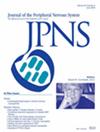The neurological core features of the infantile-onset multisystem neurologic, endocrine, and pancreatic disease: A novel nonsense mutation in an Italian family
Abstract
Aim
Biallelic mutations in the PTRH2 gene have been associated with infantile multisystem neurological, endocrine, and pancreatic disease (IMNEPD), a rare autosomal recessive disorder of variable expressivity characterized by global developmental delay, intellectual disability or borderline IQ level, sensorineural hearing loss, ataxia, and pancreatic insufficiency. Various additional features may be included, such as peripheral neuropathy, facial dysmorphism, hypothyroidism, hepatic fibrosis, postnatal microcephaly, cerebellar atrophy, and epilepsy. Here, we report the first Italian family presenting only predominant neurological features.
Methods
Extensive neurological and neurophysiological evaluations have been conducted on the two affected brothers and their healthy mother since 1996. The diagnosis of peripheral neuropathy of probable hereditary origin was confirmed through a sural nerve biopsy. Exome sequencing was performed after the analysis of major neuropathy-associated genes yielded negative results.
Results
Whole-exome sequencing analysis identified the homozygous substitution c.256C>T (p.Gln86Ter) in the PTRH2 gene in the two siblings. According to American College of Medical Genetics and Genomics (ACMG) guidelines, the variant has been classified as pathogenic.
At 48 years old, the proband's reevaluation confirmed a demyelinating sensorimotor polyneuropathy with bilateral sensorineural hearing loss that had been noted since he was 13. Additionally, drug-resistant epileptic seizures occurred when he was 32 years old. No hepatic or endocrinological signs developed. The younger affected brother, 47 years old, has an overlapping clinical presentation without epilepsy.
Interpretation
Our findings expand the clinical phenotype and further demonstrate the clinical heterogeneity related to PTRH2 variants. We thereby hope to better define IMNEPD and facilitate the identification and diagnosis of this novel disease entity.

 求助内容:
求助内容: 应助结果提醒方式:
应助结果提醒方式:


